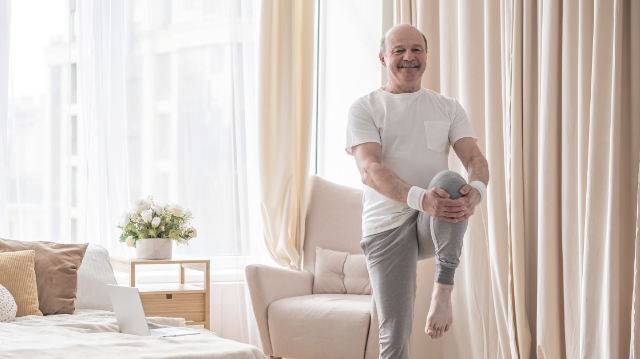
If you still have questions about what you can do to prevent falls, we have you covered. In our final post of the month, weâre going to provide answers to some of the most frequently asked questions about fall risk reduction to help ensure youâre taking all the steps necessary to decrease the likelihood of a fall for yourself and/or a loved one.
Q: What modifications should I make to my home to increase its safety and minimize hazards?
A: First, conduct a walkthrough of your homeâboth indoors and outdoorsâeither by yourself or with a friend, family member, or professional if you need assistance. Take note of any obstacles or hazards that could potentially lead to a slip or fall, such as throw rugs, clutter on the floor, poor lighting, lack of handrails or grab rails, and uneven steps. (During the winter, another danger is ice on walkways and stairs). Once these potential hazards are identified, take measures to address them by installing handrails on both sides of all stairways, removing clutterâand keeping it off the floorâremoving all throw rugs, improving the lighting in all rooms, and adding nonskid mats, a raised toilet seat, and grab bars as needed in bathrooms. Be sure to ask for assistance from a friend or family member with any tasks youâre not comfortable completing on your own.
Q: How can a physical therapist help?
A: Physical therapists are perfectly positioned to offer guidance on fall risk reduction because the entire practice is predicated on movementâbased strategies intended to increase oneâs physical function and avoid injury. A physical therapist will first perform a brief screening to determine your baseline fall risk, and if an elevated risk is detected, a more thorough evaluation of balance, strength, walking ability, footwear, medications being taken, medical history, and other parameters will follow. Based on the findings of this evaluation, the therapist will design a personalized treatment plan thatâs intended to minimize fall risk. This may include education, balance training, a walking program, strength training, endurance training, and pain management.
Q: What are some exercises I can perform at home to improve my balance?
A: Regular physical activityâlike brisk walking, gardening, and doing household choresâis a great start to increase your fitness levels and reduce your fall risk, but performing specific exercises will have an even greater impact. The best types of exercises are those that improve strength, flexibility, balance, and proprioception (sensing your bodyâs location and position in space), all of which tend to naturally decline in older age. Here are four of our top exercises to address your weaknesses and reduce your risk for falling:
- Singleâleg stance exercise: improves your balance on each leg, which will in turn help with overall balance
- Heelâtoâtoe walk: helps you better maintain your balance while moving and encountering obstacles
- Sitâtoâstand exercise: strengthens your leg, core, and back muscles, increases overall mobility, and improves balance
- Heel raise: strengthens the calf and thigh muscles to improve balance
Q: Should I ask my doctor if the medications Iâm taking could increase my risk for falls?
A: Absolutely! Doctors should always be extremely careful about choosing which medications to prescribe based on the risk for side effects and any potential interactions each drug could have with other medications, but you should also talk with your doctor before starting any new medication or if you notice any changes to your balance from the drugs youâre currently taking.
Q: How often should I get my eyes checked?
A: If youâre over the age of 65, itâs recommended that you have your eyes checked once a year. But if you notice that your vision has become somewhat fuzzy or starts to get progressively worse, donât wait for your next appointment and have your eyes checked as soon as possible.
Q: What else can I do to reduce my risk for falls?
A: Here are a few additional steps you can take to manage your fall risk:
- Always wear appropriate footwear (avoid slippers, flipâflops, and other types of footwear that can easily slip off your foot)
- Try to plan your day around your energy levels: learn your limits and donât push yourself or overstrain your body at times when you donât feel up to certain tasks, which can increase your fall risk
- Follow a healthy diet that includes lots of fruits, vegetables, and whole grains while minimizing your intake of processed foods and those with high sugar content; consider talking to a nutritionist or dietician for additional support
- If youâre concerned with your fall risk, consider using an assistive device like a cane or walker when getting around
We hope that these posts have been educational, informative, and helpful for you and/or any loved ones that may be at risk for falling. Contact us if youâre interested in learning more about how to prevent falls or would like to begin a fallâprevention program with a physical therapist.
